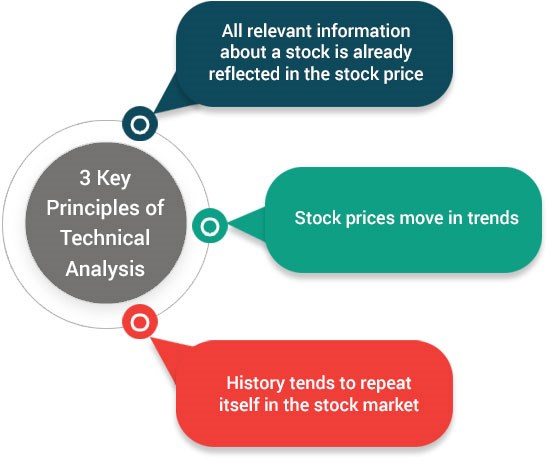Introduction
Technical Analysis is a popular technique that allows you to develop a point of view on a particular stock or index and helps you define the trade, keeping in mind the entry, exit, and risk perspectives. Like all research techniques, Technical Analysis also comes with its own attributes, some of which can be highly complex. However, technology makes it easy to understand in every kind of financial markets.
One of the greatest versatile features of technical analysis is the fact you can apply Technical Analysis on any asset class as long as the asset type has historical time series data. Time series data in technical analysis context is the price variables’ information, namely – open high, low, close, volume, etc.

In finance, technical analysis is an analysis methodology for analyzing and forecasting the direction of prices through the study of past market data, primarily price and volume.
Technicians employ many methods, tools and techniques as well, one of which is the use of charts. Using charts, technical analysts seek to identify price patterns and market trends in financial markets and attempt to exploit those patterns.
Technicians using charts search for archetypal price chart patterns, such as the well-known head and shoulders or double top/bottom reversal patterns, study technical indicators, moving averages and look for forms such as lines of support, resistance, channels and more obscure formations such as flags, pennants, balance days and cup and handle patterns.
Technical analysts also widely use market indicators of many sorts, some of which are mathematical transformations of price, often including up and down volume, advance/decline data and other inputs. These indicators are used to help assess whether an asset is trending, and if it is, the probability of its direction and of continuation. Technicians also look for relationships between price/volume indices and market indicators.

Comparison with Fundamental Analysis
Contrasting with technical analysis is fundamental analysis:
The study of economic & other underlying factors that influence the way investors price financial markets. This may include regular corporate metrics like a companies recent EBITDA figures, the estimated impact of recent staffing changes to the board of directors, geopolitical considerations, and even scientific factors like the estimated future effects of global warming. Pure forms of technical analysis can hold that prices already reflect all the underlying fundamental factors. Uncovering future trends is what technical indicators are designed to do, although neither technical nor fundamental indicators are perfect. Some traders use technical or fundamental analysis exclusively, while others use both types to make trading decisions.
Fundamental analysis is a method of evaluating securities by attempting to measure the intrinsic value of a stock. The core assumption of technical analysis, on the other hand, is that all known fundamentals are factored into price; thus, there is no need to pay close attention to them.
Types of Indicators
- Price trends
- Chart patterns
- Volume and momentum indicators
- Oscillators
- Moving averages
- Support and resistance levels
Trend
A trend is the general direction at which the stock is moving. Based on whether the market is bullish or bearish, the trends move upwards or downwards. There is a specified duration for a movement to be considered a trend, however, the longer the trend moves (either upward or downward), the more noteworthy the trend becomes.
The idea to make the most of trend analysis in the stock market is to pay attention to the industry the stocks relate to, any geopolitical or other factors that have influenced such a sector’s stocks in the past, and how market sentiment has affected such a stock.
Chart Patterns
Technical analysis is all about interpreting stock price movement and trade volumes. Information about these is widely available. However, it needs to be converted into a form that can be easily understood and used for trading. In technical analysis, this process begins with the construction of stock price charts. After this, you need to interpret these charts.
Trading chart patterns often form shapes, which can help predetermine price action, such as stock breakouts and reversals. Recognizing chart patterns will help you gain a competitive advantage in the market, and using them will increase the value of your future technical analyses.
Volume Oscillators
An increase or decrease in asset price accompanied by an increase in volume can be considered a sign of strength in the current trend. Hence, if the fast VMA or volume moving average (default 14-period) is above the slow volume moving average (default 28-period), the VO is above the zero levels. And cay be determining price direction, whether it be up or down. The indicator signifies that a trend would continue to move in the same direction or change its direction after traveling some distance in a particular direction. In order to determine the strength of a future trend, Volume Indicators like VO, PVO or MVO must not agree with the Price Indicators among all of the indicators.
Moving Averages
Moving averages can be calculated for any time frame, from minutes, hours to years. Any time frame can be selected from the charting software-based of your requirements.
EMA is quicker to react to the current market price because EMA gives more importance to the most recent data points. This helps the trader to take quicker trading decisions. Hence, for this reason, traders prefer the use of the EMA over the SMA.
Support and Resistance levels
This is a concept in technical analysis that says that the price of a stock tends to stop and move in the opposite direction when it hits certain pre-determined price points.
Support level: This is a level at which the price of a stock does not fall down any further. The price is likely to bounce back and moves up in the opposite direction. This is a level where the demand from buyers is expected to be much higher than that of sellers.
Resistance level: A resistance level is the opposite of a support level. It is a price point (ceiling) at which the stock price is not expected to rise any higher. This is a price point at which there are more sellers than buyers in the market for the particular stock.
Conclusion
Technical analysis is a form of security analysis that uses price data and volume data, typically displayed graphically in charts. The charts are analyzed using various indicators in order to make investment recommendations.




